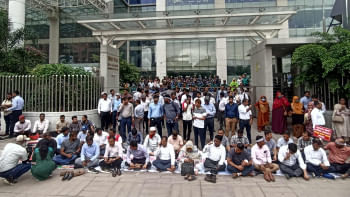Expanding the Bangladesh-China trade frontier

Chinese President Xi Jinping will be visiting Dhaka for an official visit on October 15, 2016. This is happening three decades after Chinese President Li Xiannian visited Bangladesh in March 1986. This high-profile visit has already triggered considerable optimism in all quarters due to the fact that China is the biggest trade partner and one of the most trusted friends of Bangladesh since formal diplomatic relations were established in mid-1970s. Both the countries are ready with a number of agreements worth billions, covering trade, investment and developmental cooperation, to sign during President Xi Jinping's visit.
Bangladesh-China bilateral trade has been increasing significantly over the years, both in terms of absolute amount and percentage change among Bangladesh's top trade partners. As per the statistics of Export Promotion Bureau of Bangladesh, the country's total merchandised export to China was USD 808.14 million in the year 2015-16, which was only USD 319.66 million in 2010-11. Thus, Bangladesh's export to China grew at an annual average of 30 percent in the last five years. Nevertheless, the recent export growth has been quite slow, only 6 and 2.2 percent in 2014-15 and 2015-16, respectively. The share of exports to China was merely 2.4 percent of the total export in the immediate past fiscal year.
On the other hand, merchandised imports from China have been the highest for quite some time. The extrapolated data of Bangladesh Bank shows that import from China was worth about USD 9.8 billion in 2015-16, which was USD 5.9 billion in 2010-11. However, the growth of import was considerably lower than export during this period, on average 13 percent per annum. Conversely, the share of imports of China is growing quite well; from 20.7 percent in 2013-14, it has become about 24.1 percent of the total merchandised imports from the country in 2015-16 as per Bangladesh Bank data. Together, Bangladesh's trade with China is now about 26.5 percent of its total trade with the world, which is the highest with a rising trend. If this rate prevails, the total bilateral trade would be USD18 billion in 2021, when the country would celebrate its 50th anniversary.
Bangladesh mainly imports raw materials for its textiles and clothing from China, such as cotton, yarn, fabrics, staple fibers and accessories for its readymade garments (RMG) industry, which is nearly 35 percent of total imports. The latest data of Bangladesh Bank reveals that the country imported cotton, cotton yarn/thread and cotton fabrics (19.6 percent); man-made staple fibres and knitted or crocheted fabrics (10.1 percent); man-made filaments, strip and the like of manmade textile materials (3.8 percent); and other fabrics and apparel accessories (2.8 percent). The other notable import items are boilers, machinery, mechanical appliances and their parts (16.4 percent); electrical machinery and equipment and parts (12.2 percent); and fertiliser, plastic, chemicals, and iron and steel (13.1 percent). The country also imports some food items from China.
On the export side, the top five items constituted about 80 percent of total exports in 2015-16, of which 42.2 percent is woven and knit garments as per the double-digit harmonised code. The main items are woven garments (24.5 percent), leather products and travel items (17.9 percent), knitwear (17.8 percent), paper yarn and woven fabric (12.6 percent), and raw leather (6.5 percent). Fish and footwear are also getting prominence (8.5 percent) in the export basket. Thus, a complementarity is evident in the export and import items, which is believed to create synergy especially in Bangladesh's export-oriented RMG industry. Bangladesh is basically sourcing raw materials and machinery for its textiles and clothing sector.
Despite these positive developments in bilateral trade, there are certain gray areas and constraining factors disfavouring Bangladesh in optimising mutual gains from trade. The first and foremost is very high amount of negative trade balance of Bangladesh, which is currently 85 percent of total bilateral trade. It is mainly due to low export value and its very slow growth in recent years. A slightly encouraging fact is that relative trade deficit has been on the decline — it was 90 percent of total bilateral trade in 2010-11. The declining ratio of trade deficit is perhaps due to duty-free access of around 5,000 Bangladeshi items to the Chinese market under the Asia Pacific Trade Agreement (APTA). Bangladesh, however, needs zero-tariff access of 99 percent items, including RMG products. If China grants this concession, it would significantly help reduce gigantic trade deficit, and bilateral trade would be much larger in the foreseeable future.
Further strengthening of value chain is imperative to benefit the textiles and clothing sector of Bangladesh. China is a cheap source of raw materials, which is being utilised to maintain trade surplus with the European and North American countries. Cost of importing garment inputs from China could be reduced in two ways: reducing time of clearance in sea ports by improving capacity of Chittagong port and extending Chinese production base of non-cotton RMG inputs by constructing relevant factories in Bangladesh. Though the earlier option is immediately required, the latter would help China's costly and declining industries to locate a gainful place and strengthen the bilateral value chain.
Finally, Chinese involvement in Bangladesh's two special economic zones (SEZs) and establishing a dedicated export processing zone (EPZ) for China would help boost bilateral trade and increase Bangladesh's exports to the global market. Even though the SEZ Authority is on the fast track in offering China's desired SEZs in Chittagong and Mongla, the sites have been far from ready in the last two years. There will also likely be complications in constructing EPZ as can be inferred from the experience of the Korean EPZ. Therefore, both parties should come together to assess the ground reality and expedite the process to operationalise the SEZ. The joint communiqué of Prime Minister Sheikh Hasina and President Xi Jinping should cover these issues.
The writer is Acting Research Director at Bangladesh Institute of International and Strategic Studies (BIISS). E-mail: [email protected].

 For all latest news, follow The Daily Star's Google News channel.
For all latest news, follow The Daily Star's Google News channel. 






Comments